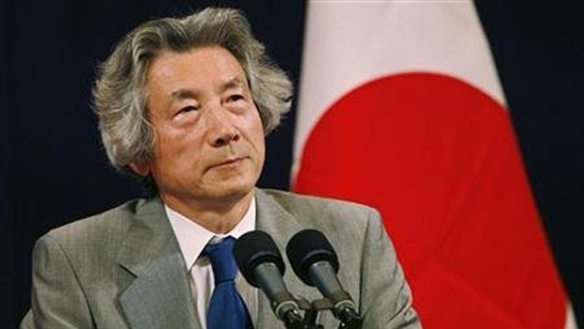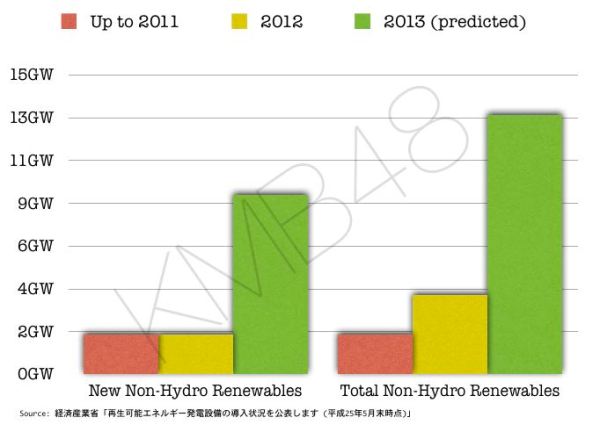*** UPDATE October 1, 2013 ***
A well recognized energy analyst based in Japan and I had a fairly in depth discussion in the comments of this post. Here is a quick summary of my take away on this issue. Please see the comments section for the details:
1. Nuclear was in fact only about a quarter (25.4%) of Japan’s total electricity generated for the five years up to the Fukushima catastrophe. Nuclear was not “about one third,” nor was it “about 30%.”
2. One reason that the share of nuclear power has been inflated is due to calculations which fudge the math to show an exaggerated share for nuclear. Some people are dividing the IEA’s Production from nuclear number into the Final consumption number instead of the Total production figure without subtracting any of the transmission/distribution and other losses. This calculation alone inflates the nuclear percentage by about 12% for 2010 alone.
3. Another reason is that some analysts are neglecting to count power generated by non-utilities such as TEPCO and the other regional monopolies. There are various reasons why specialized analysts may want to do this based on their definition of the electricity market, however, this discounts much of the electric power actually generated in Japan and further exaggerates the importance of nuclear power.
Unless a journalist, blogger, or others in the media are describing specific and clearly defined subsets of the Japanese electricity situation, the correct approximation to use is “about a quarter.”
*** End of UPDATE ***
Journalists are consistently misreporting the amount of electricity that nuclear power provided the Japanese market prior to the Fukushima nuclear radiation catastrophe in 2011. Many reports falsely state that nuclear energy provided “one third” or “30%” of Japan’s electricity before Fukushima’s reactors devastated the nation. This is simply not true. In fact, nuclear was only providing about a quarter of Japan’s electrical power in the years prior to the catastrophe.
Here are some examples of inaccurate reporting:
“used to provide almost a third of the nation’s electricity”
Reuters story by Linda Sieg
“plans to raise nuclear capacity from one-third to over half of total demand”
AP story by Elaine Kurtenbach (published on Huffington Post)
“no firm date for bringing back an energy source that had covered about a third of the country’s electricity needs”
Reuters story by Tetsushi Kajimoto
“nuclear reactors provided close to a third of the electricity to keep the $5-trillion economy going before the Fukushima disaster”
Reuters story by Osamu Tsukimori
“until three years ago provided 30% of the electricity to power the world’s third largest economy”
The Guardian story by Phillip Inman & Terry Macalister
There are numerous similarly incorrect statements in other reports.
In 2010, the year prior to the horrific catastrophe, Japan only generated 25.8% of its electric power with nuclear according to the International Energy Agency’s (IEA) statistics. Here are actual production numbers from the IEA for the five years leading up to the Fukushima radiation disaster:

Obviously, nuclear never got even close to a third of Japan’s electricity production, nor was it even thirty percent.
Why then do journalists consistently misreport this information? Well, the nuclear industry can be to blame at least in part. A friend on twitter pointed out that the World Nuclear Association’s (WNA) profile on Japan makes claims that could confuse journalists. The WNA is, however, a public relations arm of the nuclear industry and can be expected to exaggerate nuclear’s importance – it is in their vested interest.
My twitter friend also pointed out that Japan’s Federation of Electric Power Companies (FEPC) also makes a similar “about 30%” claim. The FEPC is also highly vested in promoting nuclear power and can be expected to similarly “spin” atomic energy in a positive light.
Further, another friend on twitter who is a prominent and respected journalist pointed out to me that the confusion over the numbers could possibly be since the nuclear portion of total demand, rather than total supply, might be seen as higher than 25%. This would be since actual demand or consumption of electricity is generally smaller than supply due to various losses such as transmission loss. This explanation does not make sense to me for several reasons.
One glaring reason is that neither Japan nor the IEA publishes consumption of electricity by source, only as a part of total production. It is not clear which source, nuclear or other, is being consumed. So it is very difficult, if not impossible for a journalist to report that “nuclear is X% of consumption.”
Another reason is that nuclear suffers more from transmission loss than other forms of electric power generation. Due to the very real risks that nuclear poses, atomic energy plants are necessarily located far from population centers where the bulk of electricity is consumed. As a portion of electricity consumed, nuclear would suffer more from losses than other forms of power and therefore it seems unlikely that the Japanese power industry would want to show that off.
My own best guess at this point is that the industry spinmeisters have been exaggerating the importance of nuclear power for a long time, and unfortunately, some journalists are not taking the time to check their sources or the math.
In any event, nuclear is now zero percent of Japan’s electric supply. Hopefully it will stay that way for a very long time.




